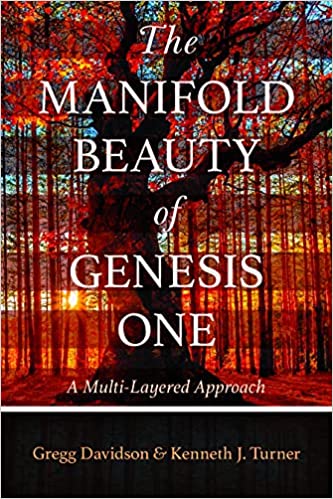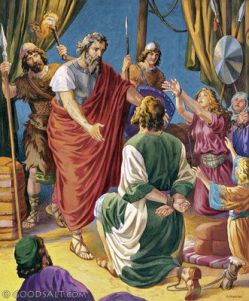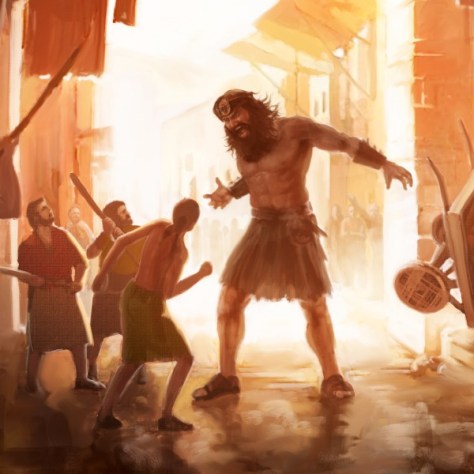The Manifold Beauty of Genesis One

The Manifold Beauty of Genesis One (hereafter referred to as Manifold Beauty) is a recent book by Gregg Davidson, professor of geology, and Kenneth J. Turner, professor of biblical languages and Old Testament. The authors desire is to explore the richness of the text of Genesis 1. Many in our time, especially in America only turn to Genesis 1 when it comes to the debate about Creation and Science. The authors, rightly in my opinion, want to draw readers back to the theology of Genesis 1. Their contention is not only that the theology of Genesis 1 is rich, but that it has many different layers to it. Hence the subtitle of the book, “A Multi-Layered Approach.”
Contents of Manifold Beauty
Manifold Beauty does not break new ground in the understanding of Genesis 1, but rather seeks to demonstrate that by viewing the text from various angles one can not only discover the richness of the text, but can gain new insights from Genesis 1. Thus the authors draw upon the scholarship of the church, both ancient, but mostly recent, to explore different truths expressed in Genesis 1. The authors begin assuring the reader that they subscribe to the view of inerrancy as expressed in the Chicago Statement of Biblical Inerrancy. In fact, they spend about a page discussing what that means. I got the distinct impression they were concerned their approach might be rejected by many in the evangelical community, or at least by those who expect a discussion of Genesis 1 to include the merits of the young earth argument. It only makes sense to me that we should seek the theological truth that Genesis1, or any other portion of the Bible, seeks to communicate, and so I found myself eager to read about the various approaches.
The authors emphasize that the seven approaches they are looking at are not in competition with each other. Even if one does not find a particular approach convincing, it does not nullify the other approaches. Furthermore, they contend that even if a certain point in a particular approach is not convincing, it doesn’t necessarily make that approach invalid. Their contention, which I believe is valid, is that the Scripture has many layers to it. Thus the approaches discussed are not in competition with one another, but are ways of viewing Genesis 1 from different vantage points.
So what are these seven approaches? I will answer this question by noting the topic of each chapter and giving a brief synopsis of its contents.
- Song–It has been noted by various scholars that Genesis one is neither pure narrative, nor pure Hebrew poetry, but lies somewhere in-between. Thus it is a unique piece of literature in the Hebrew Bible. Each day is similar to a stanza in a song, with various features that repeat throughout the six days of Creation. One of the main takeaways of this approach is noticing the parallel nature between days 1-3 and days 4-6 (with day 7 being unique, just as the Sabbath itself is different from other days). This is a common topic of modern Genesis commentaries, but for those unfamiliar with it, it can be quite eye-opening.
- Analogy–The command to keep the Sabbath in Exodus 20:8-11 is related to God’s creative activity in Genesis 1. The authors argue that God is pictured as a farmer. Each day ends with the phrase “and there was evening and there was morning,” suggesting the night period is a time of reflection and rest after a day’s work. The work is pronounced as good seven times in Genesis 1. Therefore, work is good and rest and reflection are good, as well as a special day of rest which should include thankfulness to God for His bountiful world.
- Polemic–Due to various archaeological discoveries over the past 150 years, various Creation stories from the Ancient Near East have been found. While there are some general similarities between these and the Genesis account, Genesis 1 also contains a number of features which seem to be addressing false beliefs propounded in these other accounts. For example, the belief in one God who created everything versus many, or that God did not have to fight against any forces of evil to create His good world, or that humans were created to be the pinnacle of God’s creation and to represent Him by bearing His image, as opposed to being created by the gods to do all of the work for them.
- Covenant–Although the word covenant is not found in Genesis 1, the authors, along with other scholars, argue that covenant is clearly implied. The gifting of land to humans and the result of exile (banishment from the Garden) when the covenant is broken, resemble the suzerain-vassal relationships in ancient treaties.
- Temple–A majority of scholars today see a prevalence of Temple language in Genesis 1-2. The authors concur. The seven day pattern of Creation and God taking up His rest on the seventh day reflect ancient language of Temple building. Going beyond Genesis 1 and looking at Genesis 2, the Garden is pictured as God’s sanctuary and Adam and Eve are pictured as priests who are to care for and protect Eden.
- Calendar–This is a newer approach highlighted by the research and writings of Michael LeFebvre. The following is a quote from the authors summarizing this approach: “The days of creation serve as a microcosm of each agricultural year–preparing the soil, planting, harvesting and celebrating God’s provisions with feasts and holy days. The heavenly bodies of day 4 were provided to gauge the passing of days and seasons and, looking forward, to mark the times of worship and celebration. Harvest festivals and Israel’s commemorative dates align with the agricultural calendar as reminders of God’s sovereignty and care, emphasized each week by Sabbath rest and worship” (p. 170).
- Land–The story of Creation and Eden parallels the gift of the promised land to Israel. Furthermore, “Adam’s story is Israel’s story” (p. 170). The story consists of the gift of land followed by sin and exile.
Evaluation of Manifold Beauty
The Manifold Beauty of Genesis One is an important book. Not because it breaks new ground, but because it gathers together various approaches to Genesis 1 in one place and offers a synopsis of these approaches and how they contribute to a rich understanding of the text. The focus on the teaching and theology of Genesis 1 is a breath of fresh air in the midst of the ongoing debate over Creation/Evolution, Young Earth/Old Earth. It demonstrates that a study of Genesis 1 has much more to offer, and encourages the reader to seek what might have been God’s (and the original inspired author’s) reason(s) for writing Genesis 1.
Because of my familiarity with a number of these approaches from various commentaries and monographs I’ve read, I found chapters 2 and 6 the most intriguing, as these were ideas I had not come across before. Further reading and reflection on the calendar approach to Genesis 1 (Chapter 6) is needed before I can make a fair decision on its validity. One area of possible disagreement, which again will involve more study and reflection on my part, is the authors’ contention that the introduction of sin in the world did not change the functioning of nature (p. 90). Rather, it was human exposure to some of the dangerous elements of Creation that changed. The authors argue, “Prior to sin, Adam and Eve were providentially shielded from negative interactions with the normal functions of nature. After sin, these protections were at least partially lifted” (p. 92).
The audience of this book would not only include pastors, and seminary students, but will be helpful for the interested lay person. Each chapter provides answers to potential objections, which makes the book suitable for a Bible study group. Although I found this feature helpful, the book as a whole struck me as taking a very defensive posture. At every turn of the page from the Introduction, to the questions at the end of the chapters, to the Conclusion, the authors seem very concerned that their thesis is going to be attacked or rejected and so they are constantly defending their approach. Answering objections is all well and good. I just thought the authors did more than was necessary. Whether one accepts all of the viewpoints and theological stances taken in this book, it is definitely worth reading. Areas of disagreement provide further opportunity for study and consideration which leads to further growth and knowledge in the understanding of God’s Word. Even the authors confess that some approaches are stronger than others. Overall, people unfamiliar with the various lenses through which Genesis 1 can be viewed, will profit greatly from this book.
For any who are interested in hearing an interview where the authors discuss Manifold Beauty, click on the YouTube link here. I want to thank Kregel Publishing for furnishing me with a free copy for review purposes. I was not required to give a favorable review.




























